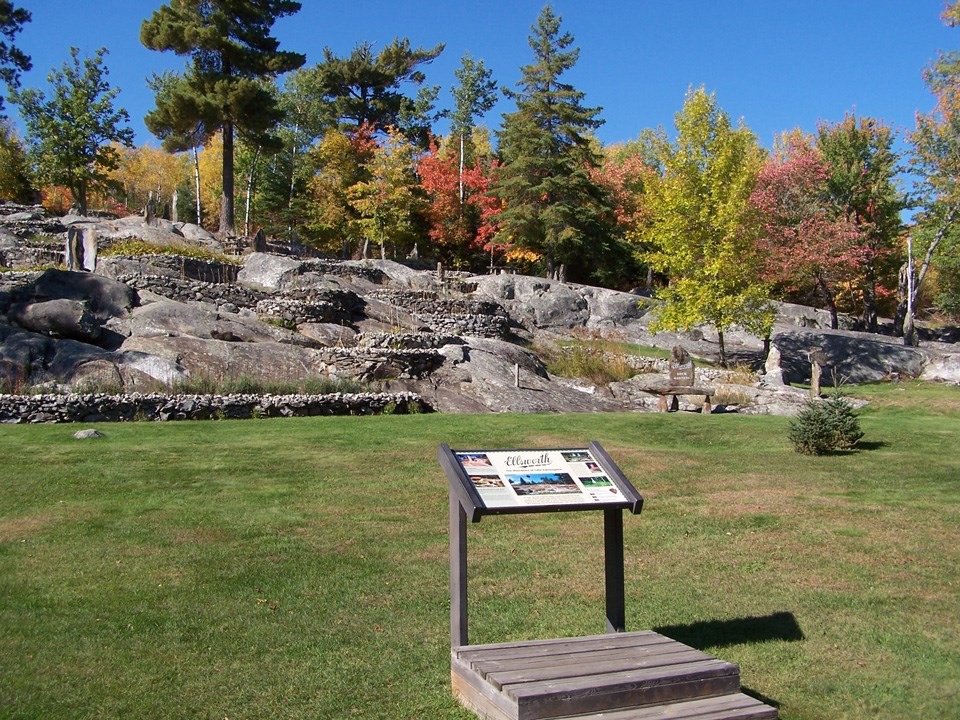50 Years, 50 Legacies: Jack Ellsworth
#18: Jack Ellsworth (1899-1974)
Ellsworth Rock Garden, Credit: NPS
Tucked along the rocky northern shore of Lake Kabetogama lies a place heralded as the “Showplace of Lake Kabetogama.” The Ellsworth Rock Gardens are an extraordinary artistic landscape – part garden, part stone sculpture park – crafted over two decades by the hands of one man: Jack Ellsworth.
A Chicago carpenter by trade, Jack Ellsworth spent his summers from 1944 to 1965 building an astonishingly complex garden on the granite outcrop of his family’s remote vacation property. What began as a lakeside retreat soon evolved into an epic undertaking of artistry and labor. With no formal artistic training, Ellsworth channeled his skills and vision into creating 62 terraced flower beds filled with more than 13,000 lilies and 28 other floral varieties. Local stone became the primary medium for his creativity, used for dry-stacked walls, stairways, and eventually, over 200 abstract sculptures that have drawn comparisons to renowned modern artists.
Stone table made by Ellsworth. Credit: NPS
Ellsworth’s intuitive process mirrored the wild terrain he worked within. He followed the contours of the bedrock, sculpting gardens that curved with the land and topping each terrace with a layer of white quartzite “frosting,” giving his work a distinctive sparkle and polish. Circulation paths, rock stairways, pools, and stone bridges added a quiet elegance to the garden’s movement, inviting exploration and reflection.
And then came the sculptures. Delicately balanced stone forms emerged in the 1960s, with Ellsworth experimenting in abstract shapes – ravens, goddesses, and celestial forms built entirely from local rock. His iconic “stacked table” formations remain a hallmark of the site today.
Yet despite the scale of the project, over 14,000 hours by his own estimation, Ellsworth never saw himself as a great artist. “I just had to have something to keep me busy,” he once said. That “something” grew into a local landmark, attracting thousands of visitors by boat each summer.
Ellsworth died in 1974, and his property was absorbed into Voyageurs National Park a few years later. Though his original cabin no longer stands, a picnic shelter now rests on its foundation. And thanks to seasonal staff and dedicated volunteers, the gardens continue to be maintained by the National Park Service and volunteers.
While Ellsworth left no detailed plans, no personal writings, and no published vision, his work endures as one of the most unique artistic legacies in the Northwoods. His gardens remain the most visited day-use site in Voyageurs National Park. They stand as a silent testament to one man’s vision, persistence, and quiet devotion to place.
Through stone, soil, and bloom, Jack Ellsworth etched his legacy into the heart of Voyageurs. And though much about his deeper intent may be lost to time, the wonder of his creation continues to inspire generations to come.
Check out the full list of our 50 legacies!
This year, we’re celebrating 50 years of Voyageurs National Park by sharing 50 inspiring stories of the people who shaped its legacy. Years, 50 Legacies is a yearlong storytelling series highlighting individuals whose lives are woven into the fabric of the park – whether through conservation work, cultural traditions, recreation, research, or personal connection.
Raise a canteen and celebrate this historic milestone with us at our 50th anniversary website. Don't forget to subscribe to our newsletter for more inspiring stories and updates!


